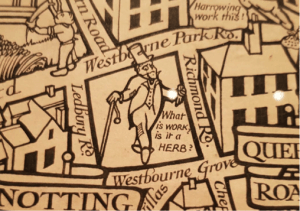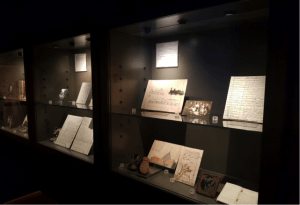BA (Hons) History of Art and Design student Sally Lawrence on the exhibition Max Gill: Wonderground Man

Figure 1: MacDonald Gill. Highways of Empire. 1927. Printed Poster. Private Collection. Authors own Photograph.
I recently had the pleasure of attending the private view of Max Gill: Wonderground Man at Ditchling Museum of Art+ Craft. I was instantly enthralled by the incredible work of MacDonald (Max) Gill (1884-1947). The cartographer, architect, letterer, decorative artist and illustrator is often overshadowed by both the remarkable work and scandalous behaviours of older brother Eric. But this exhibition clearly demonstrates that Max Gill deserves not only our attention but also our profound admiration and appreciation for capturing his world so beautifully and with a humour that is sometimes topical, but often timeless (see fig.2).

Figure 2: MacDonald Gill. Detail of The Wonderground Map of London Town. 1913. Original Pen and Ink. Private Collection. Authors own Photograph.
Gill, famously, produced maps for the International Tea Market Expansion Board, the Empire Marketing Board and most memorably for the London Underground. My favourite was his 1923 creation Peter Pan in Kensington Gardens (see figs. 3-4). This bold and vibrant yet incredibly detailed and intricate piece is a wonderful example of Gill’s exuberant style. It is so engaging that the map even includes a little message stating that ‘The Underground Railway Company would simply love to hear that by losing your train you did also lose your heart’. I most certainly did.

Figure 3: MacDonald Gill. Peter Pan in Kensington Gardens. 1923. Printed Poster. Private Collection. Authors own Photograph.
Gill’s work stretches far beyond map-making. He designed the General Post Office’s Greetings Telegram in 1937; featuring Edward VIII’s crest, which would have been used had he not abdicated. Gill designed numerous book covers and most notably he was commissioned by the Imperial War Graves Commission to design the lettering for all military headstones since WW1; as well the lettering for the Cenotaph.
Tucked away, intimately behind the main gallery’s feature wall, visitors can engage with a much more personal history (see fig.5). With examples of hand-me-down shoes, family photographs and even Gill’s earliest surviving map, produced for his brother Vernon (see fig. 6).

Figure 4: MacDonald Gill. Detail of Peter Pan in Kensington Gardens. 1923. Printed Poster. Private Collection. Authors own Photograph.
Max Gill: Wonderground Man is a thought-provoking, interesting and exciting look into the life and works of Max Gill. It is stunningly beautiful and incredibly informative; featuring works that document key moments in twentieth century history. It was curated with love and passion by guest curators Caroline Walker (great niece of Max) and Angela and Andrew Johnston (Andrew is Edward Johnston’s grandson, Edward was father of Max’s second wife Priscilla). Much of the work featured in the exhibition was stored away impeccably well by Priscilla and was then inherited by Angela and Andrew Johnston. The show features numerous maps, architectural designs, graphic designs, personal artefacts and an Imperial War Grave Commission headstone. As well as completed works, visitors can also see some of Gill’s original plans for his most famous works.

Figure 5: Display case Max Gill: Wonderground Man, Ditchling Museum of Art + Craft. 10/2018. Authors own Photograph.
I urge everyone to come and visit this incredible exhibition before it closes on 28th April 2019. Visitors can also see Changing Lives: Ditchling Artists in WW1, Wonder Craft- Local Makers for Christmas (until 1st January 2019) and Jane Pitt: Maunder Maps (from 5th January until 28th April 2019).
